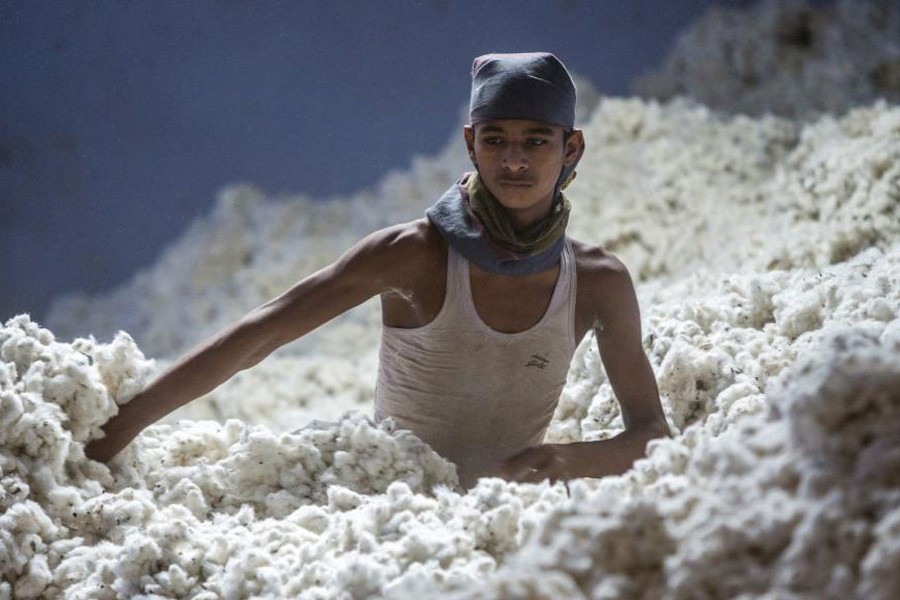That Bangladesh is currently the world's largest raw cotton importing country is a reality. This needs to be gauged in terms of two-pronged implications. One, it is clearly the use of a huge volume of imported cotton for making yarns and fabrics for the readymade garment (RMG) industry, and two, the staggering amount as high as $3.0 billion that the country has to pay annually to meet the import bills. For sometime now, import of raw cotton has been on a steady rise, and no doubt, the country has proved its competence in manufacturing cotton goods for export.
For Bangladesh as a high performing global apparel exporter, scarcity of homegrown cotton is a deterrent that our manufacturers have been trying to ride out amid many odds ever since they went into exporting. Initially, the problem was more acute as the exporters had to overwhelmingly rely on imported fabric for both woven and knit apparels. The situation has changed a lot over the past two decades with the emergence of more and more composite textile mills to make up for the dearth of fabric. Currently, thanks to local production, around eighty per cent of fabric required for apparel manufacturing is met locally - a remarkably laudable performance for a country with barely any backward linkage two and half decades back.
The last of the impediments, notably, is lack of homegrown cotton and the inevitable dependence on import. The demand for cotton is increasing day by day. Bangladesh is the fifth largest cotton consumer in the world. China is still the lead consumer although it reduced its cotton production and import in recent times. As Chinese stock of cotton is being reduced significantly, cotton price is increasing. On the other hand, the US, the largest cotton exporting country in the world, is creating a supply shortage by imposing restraint on cultivation of cotton.
Bangladesh's cotton import is likely to grow well above 7.0 million bales in 2017-18. In the preceding year, it was close to 7.0 million bales. The import bill has thus been shooting up, and lately, according to the report of a local daily, it has been hovering above $3.0 billion.
Apparel products made of natural fibre such as cotton has been the main strength of Bangladesh's exports over the decades. Many exporting countries, not endowed with sufficient raw cotton production, have moved to manmade fibres such as filament, polyesters and viscose. As a result, there has been a shift in the global trend in the use of manmade and natural fibre. With the rapid increase in the use of manmade fibre raising its ratio to well over 70 per cent globally, it is logical on the part of our apparel exporters to bring in the diversity in their product composition through increased use of manmade fibre. It has been gathered that presently, contribution of natural raw cotton is more than 90 per cent in the making of yarns and fabrics in Bangladesh.
Given the lack of homegrown cotton affecting exports as well as competitiveness of Bangladeshi apparel products, some quarters believe there is no other choice but to go for cotton cultivation-not a well tested venture though, so far. At the Global Cotton Summit held in Dhaka last week, Finance Minister AMA Muhith called for an end to sugarcane cultivation in the country, saying that the lands used for growing sugarcane should be used for cotton production. He sounded rather upset at the poor harvest of sugarcane terming it worthless in comparison with what might look rosy if the same lands were put into cotton cultivation.
For a land-scarce country like Bangladesh, large-scale cultivation of cotton, if found feasible from the points of climate, soil and other considerations, has to cope with the hard fact of land availability, and indeed, suitable land. It is not known whether the Finance Minister's remark is backed by a high level decision of his government on the matter or was it an immediate response to the textile industry people who considered land scarcity a major reason why the country is not able to meet its huge demand for cotton with domestic production.
Experts, however, do not look at the issue so simplistically. Even if the country had lands to spare for cotton cultivation, it was not just about going for it as it involved a host of factors to be taken into account to render cotton cultivation rewarding. Most of the task depends on how the agronomists find it.
Under the circumstances, industry insiders may focus on increasing the use of manmade fibre, especially viscose, which experts consider to be much cost-competitive, compared with natural cotton. The industry people - both textile millers and apparel exporters - may find it worthwhile to deliberate on the issue at length to reach a common ground.


